In the pursuit of a lean body, protein plays a crucial role. It is not only essential for building and repairing tissues but also has a significant impact on metabolism, satiety, and body composition. However, with a plethora of protein sources available, determining which one is the best protein for achieving a lean body can be a complex decision. This article will explore various proteins and their unique characteristics to help you make an informed choice.
Introduction to Protein and Lean Body Goals
A lean body is characterized by a low percentage of body fat and a relatively high proportion of muscle mass. Protein is the building block of muscle, and consuming the right type and amount of protein is vital for those aiming to achieve and maintain a lean physique. When we talk about protein for a lean body, we consider factors such as its amino acid profile, digestibility, and how it affects energy balance and fat loss.
1. Whey Protein
Fast – acting and High – quality:Whey protein is a complete protein derived from milk during the cheese – making process. It is rich in essential amino acids, particularly branched – chain amino acids (BCAAs) like leucine, isoleucine, and valine. These BCAAs are crucial for muscle protein synthesis. Whey protein is quickly digested and absorbed by the body, making it an ideal choice for post – workout nutrition. When you exercise, your muscles experience micro – traumas, and the fast – acting nature of whey protein allows for rapid repair and growth. For example, consuming whey protein within 30 minutes after a strength – training session can enhance muscle recovery and hypertrophy.
Types of Whey Protein:There are different types of whey protein, including whey concentrate, whey isolate, and whey hydrolysate. Whey concentrate contains varying amounts of protein, usually between 29% – 89%, along with some lactose, fat, and other nutrients. Whey isolate, on the other hand, has a higher protein content, typically over 90%, with lower levels of lactose and fat. This makes it suitable for those who are lactose – intolerant. Whey hydrolysate is pre – digested, which means it is absorbed even more quickly by the body, but it is also more expensive.
Metabolic Benefits:Whey protein has been shown to have several metabolic benefits. It can increase thermogenesis, which is the process of heat production in the body, thereby burning more calories. Additionally, it helps in reducing appetite. The amino acids in whey protein can trigger the release of hormones like peptide YY and glucagon – like peptide – 1, which signal satiety to the brain. This can prevent overeating and contribute to a calorie deficit, which is essential for losing fat and achieving a lean body.
2. Casein Protein
Slow – releasing and Sustained Nutrition:Casein protein is also derived from milk. Unlike whey protein, it is a slow – digesting protein. When consumed, it forms a gel – like substance in the stomach, which slowly releases amino acids into the bloodstream over an extended period. This makes it an excellent choice for providing a steady supply of amino acids during sleep or between meals. For instance, having a casein – based protein shake before going to bed can help prevent muscle breakdown during the night, as the body has a continuous source of amino acids for repair and maintenance.
Muscle Building and Fat Loss:Casein protein’s slow – release nature supports muscle building in a different way compared to whey protein. It provides a more prolonged anabolic effect, which is beneficial for overall muscle growth. In terms of fat loss, the sustained release of amino acids helps in maintaining a stable blood sugar level. This can reduce cravings for sugary or high – calorie foods, as well as prevent spikes and drops in insulin, which can otherwise lead to fat storage.
Combining with Whey Protein:Many fitness enthusiasts choose to combine whey and casein proteins for optimal results. For example, they might consume whey protein after a workout for quick muscle repair and then have casein protein later in the day or before bed. This combination takes advantage of the fast – acting and slow – acting properties of these two proteins, providing a comprehensive approach to muscle building and fat loss.
3. Chicken Breast Protein
Lean and High – quality Source:Chicken breast is a staple in the diet of those aiming for a lean body. It is a low – fat, high – protein food that provides a significant amount of essential amino acids. A 3 – ounce serving of chicken breast can contain around 26 grams of protein. The protein in chicken breast is highly bioavailable, meaning the body can easily absorb and utilize it for muscle building and other physiological processes. It is also rich in B – vitamins, which are important for energy metabolism.
Conclusion
In summary, achieving a lean body through proper protein consumption requires a comprehensive understanding of the different types of proteins available, your individual dietary needs and restrictions, fitness goals, and lifestyle factors. By carefully considering these elements, you can make an informed decision about which proteins are best for you and create a sustainable diet plan that supports your journey towards a leaner physique.
Related Topics:

